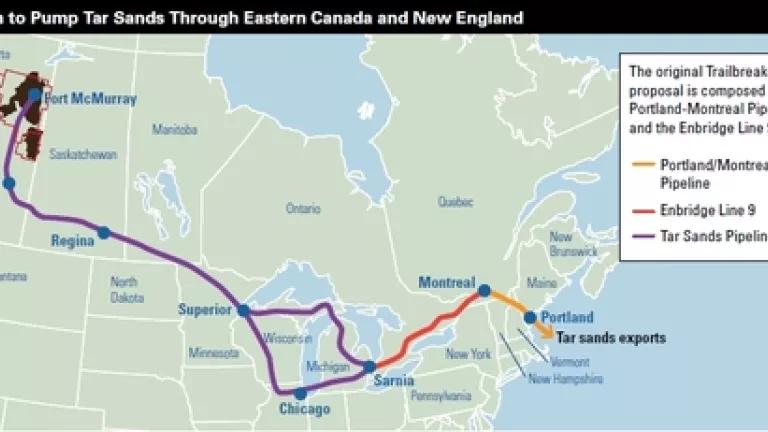
Enbridge Inc. yesterday announced major expansion plans to its pipeline system that will increase the volume of risky and dirty tar sands flowing to the United States, Central Canada, and even possibly New England. Significantly, Enbridge now plans to expand and double the capacity of the very same tar sands pipeline (Line 6B) that burst in July 2010 causing the largest tar sands spill in the United States. The expansion of this tar sands pipeline amounts to double-jeopardy for the community of Marshall Michigan who has faced over 20 months of a prolonged and expensive cleanup of their local river. Enbridge’s expansion plans also reveal they plan to ship tar sands through Ontario and Quebec to Montreal – a region that currently does not import tar sands. Bringing tar sands to Montreal also opens the door to importing tar sands to New England. Increasing the volume of tar sands coming into the United States deepens our troubling reliance on one of the dirtiest fuels on the planet. Tar sands – a thick, gooey, and heavy substance that is more toxic and corrosive than conventional oil – poses much greater risks than conventional oil. And it is very troubling that Enbridge’s plans will introduce tar sands to parts of Canada and potentially parts of New England for the first time bringing new risks to waterways, public health, and local economies.
A fact sheet on the prospect of tar sands coming to Central Canada and New England can be found here.
Late yesterday, Enbridge announced a series of projects including expansions and reversals of several of its existing pipelines. The plans include expanding several of its main tar sands pipelines as well as pursuing pipeline reversals enabling Enbridge to bring tar sands further east. Enbridge is not just importing more tar sands to parts of Canada and the United States, they are increasing the potential for more tar sands spills which pose major threats to water supplies and the economy of local communities. For example, the expansion plans by Enbridge will enable them to double the capacity of a tar sands pipeline that spilled 1.2 million gallons of tar sands on the Kalamazoo River in Marshall Michigan in 2010.
The Kalamazoo River tar sands spill – the largest in U.S. history – has had a profound and negative impact on the nearby community of Marshall Michigan who has experienced health problems and negative economic impacts that continue to this day because the spill is not yet cleaned up. Tar sands oil is transported through pipelines as a mixture of tar sands and light natural gas liquid and other volatile petroleum products. Because this substance is heavier, more corrosive, and contains more toxic chemicals and compounds than conventional crude, tar sands spills inflict more damage than conventional oil and are far more difficult to clean up.
Costs to clean up the Kalamazoo River have escalated to $750 million – 18 times as much per litre as conventional crude over the last 10 years. The clean up of the Kalamazoo river spill which has lasted almost two years has been especially difficult because conventional oil response techniques have been ineffective according to the EPA. While conventional oil floats on the surface, tar sands is thick and heavy and sinks in water making it very difficult to clean up. Between 2007 and 2010, pipelines transporting tar sands oil in the northern Midwest have spilled three times more per mile than the U.S. national average for conventional crude.
Enbridge’s announcement is also significant in that it finally reveals their true plans – to bring tar sands to Montreal, Quebec where tar sands can easily be shipped southward into New England revitalizing a plan first introduced in 2008 called Trailbreaker. Late last year, Enbridge sought regulatory approval to reverse a smaller portion of one of its pipelines in Ontario, Canada. Environmental groups in Canada and New England demanded that Enbridge come clean and share all of their expansion plans (the project was called Phase 1) to learn about the true plans by Enbridge to ship tar sands eastward. In April, NRDC and several other groups sent in 40,000 comments to Canada’s National Energy Board demanding that Enbridge come clean on its long-term plan to bring tar sands to the United States.
Yesterday’s announcement finally revealed Enbridge’s real plans which what NRDC suspected – to ship tar sands much further east to Montreal. Environmental Defence Canada and Equiterre called Enbridge’s announcement to bring tar sands to Montreal a “bait and switch” on the eve of public hearings to discuss only a portion of the plan. According to Gillian McEachern with Environmental Defence Canada, “Enbridge's plan would to saddle Ontarians with more air pollution and more risk of toxic oil spills into our water to help get more tar sands oil out of the country, and worse, has tried to avoid a full public debate about the impacts of its plan.”
NRDC and others have asked Canada’s National Energy Board to conduct a comprehensive environmental assessment of Enbridge’s broader plan to bring tar sands into the United States especially given that tar sands poses a much greater risk of spills threatening water supplies. Ultimately, Enbridge needs to reveal its real plans to ship tar sands to New England, something that has been acknowledged by Enbridge as very possible as recently as October 2011 but has never been officially confirmed. The true costs of relying on tar sands needs to be something that is fully understood and considered as part of a full and comprehensive public process given the increased risks to waterways and public health.
